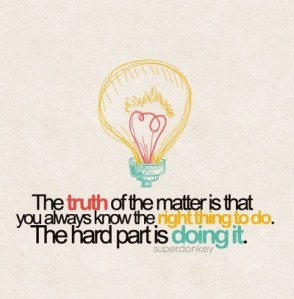I have been talking to a close friend of mine a lot over the last couple of weeks and this spiritual self-growth path is something she’s become more interested in over the last couple of months. A question she asked me recently was “How can I learn to listen to my inner self?”. I was thinking “GOOD QUESTION” because after 5 years of reading books, seminars, blogs, etc it’s been something I have been focusing on more then I have before. Especially since I have been reading “May Cause Miracles”.
Listening to your Inner Self is, I think, one of the most important things you can learn to do on The Path to reach your highest potential. YOU have all the answers you need right there in that heart of yours. We often seek advice from others be it friends, family, teachers, counselors etc and we want THEM to give us answers and tell us what to do. Why? Because we don’t take the risk or responsibility for the outcome. Some of us become so used to ignoring that little whispers of our hearts that we just don’t think it even exists. But it does and I found this awesome article on Tiny Buddha that explains ways you can start to HEAR it better.
7 Steps To Hear Your Own Inner Wisdom By: Lindsey Lewis
“I don’t know what to do.” “I can’t figure it out.” “How do I know which choice to make?” “Which one is right for me?”
Sound like someone you know? Here’s one thing I know for sure: You’ve got the power. You’ve got the love.
You’ve got the innate talent—you gorgeous, loveable soul—to know without a doubt what is right for you. You’ve got the power to know what to do, to figure it out, to know which choice to make. Your soul is calling. And all you need to do is listen.
At one time not so long ago my innate talent was ignoring my soul. I had developed an acute ability for lasering ahead no matter what my essential self was saying—even when it was “Wrong way!”
I set goals and made plans and went for it no matter what—and soon I was a stressed-out, exhausted insomniac. So that was fun.
In fact, fun was exactly what was missing from my life. I put external touchstones ahead of inner happiness. I let my ego tell me what to do, based on what I thought the standards for success were.
I bought into the mantra: Work, work, work and then work more. You can enjoy your life when you’re retired. It was no wonder my entire system went into revolt; it’s no wonder our systems do that. They’re designed to tell us when we’re off track.
They’re designed to tell us when we’re on track, too. It’s like magic—except scientifically-proven. The verbal part of our brain processes about forty bits of information per second. That’s pretty impressive.
The non-verbal part of our brain processes about eight to eleven million bits of information per second. Eight to eleven million!
That means that the thoughts we hear from the verbal part of our brain actually know less than the physical sensations and emotions that we feel coming from the non-verbal part of our brain.
So if “I don’t want to make this one choice but everyone tells me I should” seems logical, but every physical sensation or emotion about it just feels so wrong, it probably is. Wrong, that is.
Wondering how to tap into your own innate talent for knowing how to live the life that’s right for you and be who you want to be? Start small.
1. Start small.
Begin with simply noticing physical sensations. Check in with your body from time to time. What physical sensations are you noticing right now?
2. Fine tune.
Once you start to check in with your body, you’ll probably also notice emotions, and associations with whether or not the emotions you’re feeling are good or bad. It’s normal—but in this case it’s not all that helpful. Keep on fine-tuning your radar until you’re paying attention to only physical sensations.
3. Benchmark your “yes.”
Make a list of times that you knew things were right for you, or felt that things were exactly as they were meant to be, really great, going well, etc. Then do a body scan: What physical sensations do you feel? Write ‘em down and then label them.
4. Benchmark your “no.”
Make a list of times that you knew things were not right for you, or felt that things were not as they were meant to be, not going great or well, etc. Then do a body scan: What physical sensations do you feel? Write ‘em down and then label them.
5. Practice.
You’ve just created your body compass. Using it is fun. Orange or apple? Imagine making each choice and then see what physical sensations come up—closer to “yes” or closer to “no”?
6. Trust.
The verbal part of your brain might come up with all sorts of reasons why you shouldn’t trust your body compass. Practicing on the little things helps to build up enough trust to use it on the big decisions.
7. Live it in the moment.
Once you’ve got your compass down pat, keep on using it. Living it in the moment is about remembering your innate talent for knowing, and using it with reckless abandon and firm intention.
What’s your inner wisdom telling you?
Take some time to really think about these steps and start practicing them in your daily life and decisions. Like the article said, START SMALL. I hope this helps!
xoxo,



I LOVE THIS!! It definitely helps :)))
LikeLike